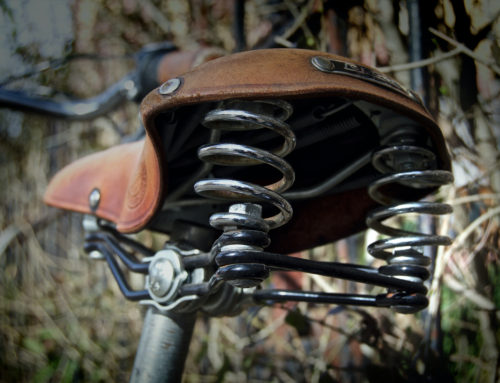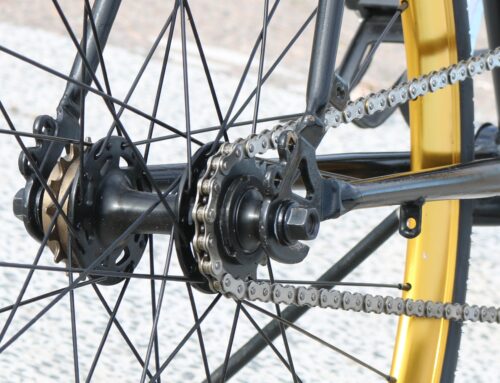In this article we show you the differences between hydraulic and mechanical disc brakes. We will show you their characteristics and which one adapts better to your needs.
Both systems work well but each has its peculiarities depending on whether the use is for city, mountain or road cycling.
The answer to this question will depend on the use of the bicycle and the rider. The advantages of the hydraulic brake are more braking power and less fatigue in the rider’s hands. On the other hand, the advantages of the mechanical are less weight and less maintenance, the bike will pass less time in the bike shop.
How do hydraulic disc brakes work?
We know that disc brakes on a bicycle are an evolution of the automotive disc brake, especially on motorcycles, but how does the disc brake really work on a bike?
The hydraulic brake system consists of three distinct parts. On the one hand we have the levers, on the other hand a hydraulic circuit through which the brake fluid flows and finally a brake caliper where the brake pads are placed, which are the ones that press the disc that is attached to the wheel and thus the braking occurs.
Therefore we can summarize it in: Lever, hydraulic circuit, brake caliper, piston or pistons as there may be several, pads and disc.
The brake pads are what we normally change since it is what suffers more wear because the friction with the disc that is attached to the wheel makes them wear.
The pads are placed inside the calipers. And these calipers are pressed by pistons called pistons and is what presses the pad against the disc and makes the bike brakes.
As we said this type of braking is developed from automotive systems in both cars and motorcycles for many years that are used and passed to mountain bikes first and now also to road bikes, gravel and even urban bicycles. In all bicycle disciplines we can already see the hydraulic disc brake.
What we have numbered so far are the parts that roughly make up the disc brake but we could also go into more detail and see what breaks down the caliper and what breaks down the lever, see their respective exploded views depending on the brand. Each brand has a different exploded view with different spare parts.
And because a hydraulic system is chosen for the disc brake system, because to achieve that with less force of the brake lever we get a very powerful braking and this is based on Pascal’s principle which is called the hydraulic press. The hydraulic press as we see in the braking system is a device consisting of two plungers. In one the surface area is smaller and a small force is applied and in the other with a larger surface area a multiplied force will be developed. By making the surface of the lever piston smaller than the surface of the brake pistons, the force developed in the pistons and therefore in braking is much greater than the force we apply with our hands on the brake lever.
That is why the great advantage of the disc brake over the conventional one is that we can brake with only one finger and with much less fatigue in our hands when braking.
But… What about mechanical disc brakes?
Mechanical brakes provide good braking power to the bicycle, but this can cause the wheels to lock up.
They have a simpler mechanism, which consists of actuating the braking by means of a brake line. Their maintenance consists of keeping an eye on the wear of the brake pads and the rope.
This is a more economical braking system but also uses less technology, which means that it is used on very low-end bicycles.
Which one is better?
Mechanical brakes act with a cable that is tensioned or released by pressing the brake levers, like conventional non-disc brakes. When the cable is tensioned, the brake caliper closes and the brake pads cause the disc to brake.
Hydraulic brakes, on the other hand, have a hydraulic circuit, as the name suggests, and inside the casing there is no cable but a liquid. Different oily liquids in a hydraulic circuit with a fluid similar to that of the brakes of the car. When the lever is actuated the oil is distributed throughout the brake hose until it reaches the caliper where it pushes the pads towards the disc so that they rub and therefore brake the bicycle.
Thus in a mechanical disc brake system the pressure exerted on the lever acts through a steel cable that pulls the pads and moves them towards the disc, the power exerted is therefore directly applied on the levers, which produces more fatigue in the cyclist’s hands and produces a drier braking since more force must be applied to brake. In the hydraulic system, on the other hand, the braking is excellent and the braking power is high, exerting less physical force and causing less fatigue in the hands, the control and feel of the braking is much more manageable.
In mechanical brakes the installation of the braking system is simpler since it is only necessary to install and tighten the casings and cables as in conventional brakes, and the maintenance is also simpler since it consists of replacing the pads, cables and casings due to wear. On the other hand, in hydraulic brakes the installation is more complicated and complex as it is still a hydraulic system where the system itself will take into account the possible leakage of fluid and there will be more rubber seals to avoid all points of fluid leakage.
Maintenance is also more complex due to the system itself, since it will be necessary to purge the hydraulic circuit from time to time, eliminating possible air leaks.
6 key differences between hydraulic and mechanical brakes
There are many differences between hydraulic and mechanical bicycle disc brakes. The following are the ones we consider most relevant when choosing one system over the other.
-
Drive
Both systems have the same essential parts: lever, hose or cable sleeve, caliper, pads and disc. But they differ in the technology used to operate.
In the mechanical brake, the force applied to the lever is transferred to one of the pads (not both) via a brake cable under tension. In the hydraulic brake, the force exerted by the rider on the lever is transferred to the caliper pistons – and from there to the two pads – by means of a fluid (mineral or synthetic oil, depending on the brand of brake). Due to the pressure exerted by the fluid, the pads will eventually move to squeeze the disc and thus slow down the movement of the wheel.
-
Braking behavior
The use of a cable or a fluid to transfer energy through the braking circuit substantially changes the type of braking.
A hydraulic disc brake will offer a more linear and progressive braking behavior (from less to more). The wheels will not lock suddenly, reducing the risk of a mishap or fall and favoring better control and handling of the bicycle.
A mechanical disc brake, on the other hand, provides a more abrupt, less linear type of braking. The braking power may be greater at the first moment of braking, but the rider has less margin to modulate the braking energy according to his or her needs.
On steep descents, for example, mechanical braking is less effective than hydraulic braking.
-
Wet performance
Related to performance, another major difference between hydraulic and mechanical brakes is their level of effectiveness in the rain. A situation in which good brakes are essential.
On wet or slippery terrain it is better to have hydraulic disc brakes, and not only because of their greater braking progressiveness.
The circuit of a hydraulic disc brake is completely closed and is more watertight.
In mechanical disc brakes, the cable is exposed at its connection to the caliper. Thus water is more likely to come into contact. It will enter to the circuit and modify its operation reducing braking power and modulation.
-
Brake adjustment
Hydraulic disc brakes are self-adjusting in terms of power, modulation, etc. Thanks to the properties of the brake fluid which is responsible for their operation.
On the other hand, mechanical brakes will need periodic adjustments to calibrate its power and modulation through cable tensioning or slackening.
Remember that the adjustment of the mechanical disc brake is made on both pads, but separately. Only one of them receives the force of the lever through the cable while the other is fixed and will require its own adjustment to be properly aligned with respect to the other.
-
Disc brake maintenance
Hydraulic brakes are much easier to maintain and are more durable than mechanical brakes.
All you need to do is to check the system annually and bleed the circuit, changing the brake fluid for a new one. This is a somewhat more thorough operation, but not very frequent and will increase the brake’s durability.
Mechanical disc brakes, on the other hand, are more easily out of adjustment. They require more constant maintenance, although simple, very similar to the classic shoe brakes. In addition, their durability is more limited than that of hydraulic brakes and the pads tend to wear out more quickly.
-
Price
Finally, one of the aspects in which both braking systems differ the most is the price. A hydraulic disc brake kit costs around €60, while there are mechanical alternatives at half the price.
Therefore, hydraulic disc brakes, although very widespread today in all assemblies, are more typical of middle and high ranges. While mechanical brakes, which were the first types of bicycle disc brakes to appear on the market are limited to the lower ranges.
However, it is no longer difficult to find inexpensive bicycles that include hydraulic disc brakes, especially on mountain bikes.
Hydraulic or mechanical: which brakes should I choose?
Once we know all the characteristics and differences between hydraulic and mechanical brakes for cycling, it is time to choose the most suitable one, according to your needs, level, use you give to the bike and available budget.
Mechanical disc brakes are suitable for novice cyclists who ride short, easy rides without too many technical sections.
On the other hand, for someone who rides regularly and has a certain level. It is more advisable to buy a bike with hydraulic disc brakes, more suitable for safely overcoming technical descents and obstacles, in the case of mountain biking or cyclocross, or descents of mountain passes in the case of road cycling.








